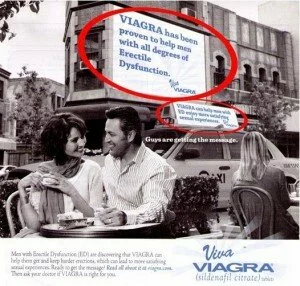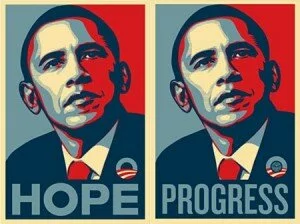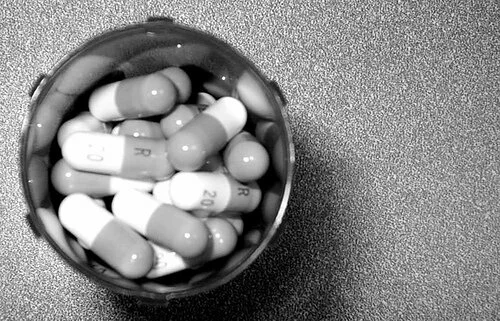
As those following the healthcare debate are aware, President Obama has backed off his campaign promises to legalize drug reimportation and require drug companies to negotiate drug prices with Medicare. Apparently deciding that healthcare reform would be defeated if he had to fight both Big Insurance and Big Pharma, he has decided to let Big Pharma off the hook.
Now, “healthcare reform” has become “health insurance reform” in the president’s speeches.
Millions of Americans, as well as many in Congress, are frustrated by this decision. And perhaps this frustration is behind current efforts in Congress to ban pharma ads directed at consumers.
Let me play prognosticator for a moment: It’s not going to happen.
Believe me, I would like to see it happen. Drug ads have been directly responsible for a dramatic increase in prescription drug use since they were legalized in the 1990s. Only the United States and New Zealand allow such ads to be shown to the public. The rest of the world knows better.
But in a short time, pharmaceutical advertising has emerged as a $4.5 billion-per-year boon to the media and advertising industries. That advertising, in turn, has led to exploding profits for Big Pharma, and trickle-down benefits for everyone in the supply chain, right down to Wal-Mart and its $4 generics.
Once a cow like that has been let out of the barn, there’s no way you’re getting in back in.
Nonetheless, the New York Times asked its readers what they thought of pharma ads, and the overwhelming majority of respondents said they wanted to see the ads altered or banned. I thought you’d be interested in seeing a few of the responses:
From pharmacists –
As a pharmacist I have seen first hand what these ads do, and there is no question that they work dramatically. For this we are paying a tremendous price. The patients demand these drugs in some instances and too many physicians give in to the requests. All drugs have side effects and some of these newer drugs not only are proven later on to have side effects not seen in clinical trials but they are costly and have no benefit over older drugs that are time tested and may be available as generics.
As a pharmacist, I see how damaging direct to consumer marketing is. The reality is that there is a large segment of the populace that will see a commercial, and then want that item. Whether it is a new car, a new phone, Ipod or drug. The sexiness of the marketing just increases the appeal of that consumer good. Frequently patients demand the prescriptions from their physicians. They make up symptoms, pester the doctor, go to many extremes to get what they want. And that doesn’t even include the free coupons available on-line and in magazines that further the demand by the patients.
From physicians –
As a physician who has to deal with the pharmaceutical industry on a daily basis, I can tell you that the information they provide me is very biased. They like putting a positive spin on non-relevant data to entice me to prescribe their products. The fact is generic drugs are often as effective as the branded products advertised on television.
I’m a family doc in Colorado, in practice for 32 years now. I find it ridiculous that I can no longer accept a ballpoint pen from a drug company because that might influence me to prescribe their product, but companies are allowed to spend millions and millions on TV and print ads aimed at patients who have no idea that they “need†such medications. Why do the same meds cost more here than in Canada? Try cutting these advertising budgets and I bet you’ll see prices come down!
As a physician, I can not recall a patient ever coming to me with information from an advertisement that helped them, or me. The ads are designed to sell drugs, not educate. Patients are convinced by the ads that they should “ask their doctor†about them, but we already know about these products from the medical literature (and the ads aimed at physicians!). When patients ask about a drug they saw an ad for, it generally takes a lot of time to convince them that what they are on already is doing well for them, or that they don’t have that condition, or the medicine is more of a risk than they need to take. I allow 30 minutes for a follow-up visit and would rather spend that time examining them and talking about what we should really be doing, than talking about an inappropriate medicine.
From consumers –
What upsets me is that ads for Viagra and similar products are aired at all hours and on all kinds of programming. When I’m watching an afternoon baseball game with my 7-year-old son, we’re inundated with these ads and their ridiculous warnings. My son and daughter have seen so many of these ads that they go around the house singing the Viva Viagra jingle. There must be some limits on these ads — at least as to when they air.
We are raising kids with the idea that taking a pill can solve almost any problem — even the simple discomfort of being shy at parties. Is social anxiety disorder a valid illness? Yes. Is mass advertising the most effective way to reach and help those people? No. But it’s a great way to convince the rest of us that we need that pill.
I agree with all these points. Who knows — maybe most thoughtful Americans do as well. But it doesn’t matter. Prescription drug advertising is here to stay.
 Anne Dunev at The Huffington Post recently called attention to a thought-provoking article published at the peer-reviewed journal of the Public Library of Science. Titled “The Cost of Pushing Pills: A New Estimate of Pharmaceutical Promotion Expenditures in the United States,” the 2008 article by Canadian academics Marc-André Gagnon and Joel Lexchin concludes:
Anne Dunev at The Huffington Post recently called attention to a thought-provoking article published at the peer-reviewed journal of the Public Library of Science. Titled “The Cost of Pushing Pills: A New Estimate of Pharmaceutical Promotion Expenditures in the United States,” the 2008 article by Canadian academics Marc-André Gagnon and Joel Lexchin concludes:
From this new estimate, it appears that pharmaceutical companies spend almost twice as much on promotion as they do on R&D. These numbers clearly show how promotion predominates over R&D in the pharmaceutical industry, contrary to the industry’s claim … (I)t confirms the public image of a marketing-driven industry and provides an important argument to petition in favor of transforming the workings of the industry in the direction of more research and less promotion.
Dunev elaborates on the way the pharmaceutical industry’s drive for growth has distorted public perceptions of diseases and how to treat them. She writes:
You don’t have to be a financial pundit to know that any public company is responsible first and foremost to their stockholders. As a public company how do you meet your fiduciary responsibility? You ensure the price of your stock by increasing your bottom-line.
Does that require that you make up new “diseases” as you go? (Restless Leg Syndrome, for example.) Do you bend the rules of science in how you determine what constitutes disease so you can repackage old drugs that have lost their patent? Do you push dangerous new drugs on the market knowing that a little collateral damage is the price of making money, just as it is the price of making war?
According to USA Today in 2005, there were 1,274 registered pharmaceutical lobbyists in Washington, D.C. — more than two for every member of Congress. In 2003, $143 million was spent on lobbying activities by the Pharmaceutical industry. There are more lobbyists from pharmaceutical than any other industry trying to bend legislators’ ears.
This is big business, and that means that your health care is not in the hands of people who really want to help you, but in the hands of people who view you as a market. Caveat emptor.
Clearly, whatever healthcare reform the government enacts must include some control over pharmaceutical marketing. Remember, less than 20 years ago, direct-to-consumer advertising by pharmaceutical companies was not permitted by the FDA. That would seem to be a good start as we try to get drug costs back under control.

Sometime back, Effect Measure posed a question many of us have pondered about direct-to-consumer (DTC) pharmaceutical commercials: What’s with the side-by-side bath tubs in the Cialis ads?
Here are some of the answers given in comments –
- “Cialis really gets your pipes flowing or plumbing flowing…”
- “Bathtubs — because you can’t show naked, mutually aroused adults on the sandy beach on TV, but you can imply they are naked and mutually aroused whilst lounging in soapy tubs on a sandy beach on TV.”
- “I think it is to convey the impression that Cialis is ripe for a slow, romantic build-up to sex and not as much about rushing to the goal. Take your time, relax, have a wonderful evening just ‘being’ with your partner.”
OK, now I have another question: Why are these ads — or ANY ads for prescription drugs directed at consumers — allowed on television or anywhere else?
This is a topic we’ve covered before. We’ve told you that only two countries in the world — the United States and New Zealand — permit DTC pharmaceutical advertising. We’ve shown you how the billions spent on DTC advertising lead American consumers to purchase more drugs than they need, and pharmaceutical companies to charge more for their products than they should.
DTC advertising was OKed at a time when “deregulation” seemed to be the default answer to every public policy question. It didn’t hurt that Big Pharma was putting big money into pockets all over Washington, D.C., to make this happen, either.
But the FDA’s attempts to ensure that Big Pharma advertising is “educational” (the industry’s official argument for DTC ads) as opposed to simply — well, advertising — have proven increasingly awkward.
We all know that the FDA-mandated warnings about side effects, which must appear in every ad that describes what a drug does, have become a national joke.
Last month, the FDA warned pharmaceutical companies that all of their online ads need to include these warnings, too. This goes for those all-text ads in Google search results that give you fewer characters than a Twitter message to sell your product. Good luck adding side effects to those.
And now, last week, the FDA warned drug companies against including “distracting music and images” in their TV commercials.
According to Reuters:
Television ads for drugs and medical devices should avoid distracting images and music that can reduce viewers’ comprehension of potential side effects, U.S. regulators advised in guidelines proposed on Tuesday.
Advertisements also should use similar type styles and voice-overs when conveying benefits and risks, the Food and Drug Administration said.
In the new guidelines, the FDA said busy scenes, frequent scene changes and moving camera angles “can misleadingly minimize the risks of the product being promoted by detracting from the audience’s comprehension.”
Hey, FDA, do you know what an ad is? Here’s a hint: It’s not a 30-second documentary. It’s a sales message that uses images, music and whatever else it can to sell a product.
For pharmaceutical companies, its only purpose is to get you to “ask your doctor for it by name” the next time you want to sit in beachfront bathtubs, side by side, with your sexual partner.
Which is why these ads should never have been legalized in the first place.
“Ask your doctor” if he or she agrees with us on this. I bet they do.

I recently came across a remarkable blog rant by a man named Jim Thornton, a competitive swimmer at age 56. Under a list of his latest swimming times, he shared the story of some of the struggles he’d recently been having with healthcare and prescription drug costs.
An excerpt:
Our health insurance went up to $1711.50 a month for a plan that requires each member of the family to spend $1400 a year before complete coverage kicks in. For a variety of complicated reasons, we cannot alter any of the terms of the policy. It is a take it or leave it situation. If we leave it, my wife and I have been taking statin drugs and antidepressants and will not be able to obtain individual policies that are not even more exorbitant than the extortionary policy we already have.
As close to unaffordable as it is this year, it seems certain that even modest increases in the years to come … ensure we will not be able to pay, most likely within two or three years.
We got audited by the IRS three weeks ago, and a large part of this was because our accountant set up a plan by which I could pay my wife a salary and give her and her family health insurance as a benefit. By doing this, I could deduct as a business expense not just the premiums but the out of pocket expenses, too. The IRS is challenging this…
So, let me get this straight:
US Big Pharma is granted the legal right to join New Zealand as the only two countries in the industrialized world to shamelessly tout ads on TV direct to consumers for drugs, creating demand for antidepressants, cholesterol lowering drugs, penis inflaters, hay fever and allergy meds, and so forth, all for chronic conditions that often require life time treatment, trumping up demand.
US Big Health Insurance is granted the legal right to cherry pick through “medical underwriting” any individual who has ever taken any of the above drugs and deny him or her coverage or charge exorbitant rights.
Big Pharma, furthermore, lobbies to block the reimportation of their drugs from Canada and pretty much any other country in the world, where the exact same thing costs anywhere from 50 percent to 8 times less. The rational: the FDA cannot assure the safety of reimported drugs, even ones in factory sealed bottles…
If you work for a big company, you can qualify for cheap health insurance, but this for all too many people just becomes yet another way to keep you as a virtual indentured servant, putting up with abusive managers demanding you do unethical things to up the profit margins, work nonstop, ignore your family, etc.–all because they know a lot of people have become so stressed out and fat and unhealthy because of their jobs they CAN’T quit because they won’t be insurable.
What, I ask you, is not a PONZI scheme in our modern land of liberty?
Can you relate?

President Obama’s economic stimulus plan includes funding for “comparative effectiveness research,” which would study various prescription drugs, along with medical treatments and devices, to determine which perform best for the least amount of money.
As the Washington Post describes the program:
What’s best for insomnia — Lunesta, at about $6 a pill, or Zolpidem, at $2?
Should a man with prostate cancer choose radiation, surgery or “watchful waiting”?
Is it better to operate on a bad knee or get an injection of the joint fluid known as Visco.
To help doctors and patients decide, President Obama has dedicated $1.1 billion in the economic stimulus package for federal agencies to oversee studies on the merits of competing medical treatments.
The approach, known as comparative effectiveness research, is aimed at finding the best treatments at the best prices. Proponents say reducing ineffective or unproven care is one way to rein in health costs, which consume nearly 18 percent of the gross domestic product, straining family budgets, company profits and the federal government.
Big Pharma fought hard to remove this research from the stimulus bill, for obvious reasons — their business is based on maximizing profits, not maximizing cost-effectiveness.
As physician blogger Kevin MD writes:
Physicians need an authoritative source of unbiased data, untainted by the influence of drug companies and device manufacturers.
With treatments and medications announced daily, having an entity definitively compare these newer, and often more expensive, options with established treatment regimens will be particularly useful in everyday practice.
The only way to tackle such a huge project is with money, and indeed, the Obama administration recognizes this fact by including $1.1 billion in comparative effectiveness research in the economic stimulus package.
Clearly, the pharmaceutical and device industry would like both the public and physicians to continue to assume that “newer means better.” Not asking these questions allows them to continue promoting profit-making brand-name treatments.
Their motives in attempting to quash comparative effectiveness research could not be more obvious.
Healthcare policy guru Ezra Klein adds:
The fight over comparative effectiveness research is really a fight over who controls information. Right now, the pharmaceutical industry pays for most of the research and funds the most effective research distribution service (this service, incidentally, comes in the form of leggy former-cheerleaders and Miss America contestants…). That’s good for the pharmaceutical industry, which can emphasize the research aligns best with their business strategy.
The threat of comparative effectiveness review is that Pharma loses control of the information. An alternative information pipeline opens up. This one, to use Kevin’s evocative sentence, would be “untainted by the influence of drug companies and device manufacturers.” (It also won’t be delivered by former cheerleaders.)…
But don’t begrudge Pharma its efforts. As Kevin says, “their motives in attempting to quash comparative effectiveness research could not be more obvious.” The current regime is good for profits. And protecting profits is Pharma’s job. But it’s not good for the public. And protecting the public welfare is the government’s job.
I stumbled across this while reading Gawker: “Teen socialite” Peaches Geldof says the staff at the fashion magazine Nylon prefer prescription drugs over illegal drugs –
What’s the drug of choice at Nylon? “Klonopin.†Peaches was definitely the talky one. Why? “It’s just a very large prescription drug culture. 
This confirms our highly anecdotal evidence of Klonopin as a mini-trend for the creative underclass, maybe better than Xanax—not that our shrink is offering to prescribe us any despite repeated inquiries.
Klonopin, classified as a “sedative-hypnotic,” is prescribed for epilepsy, panic and anxiety disorders, restless legs syndrome and other medical conditions. Unfortunately, such drugs are too easily obtained by young people, who often start taking them by raiding their parents’ medicine cabinets.
As Ritch Wagner of Purdue Pharma (OxyContin), who educates medical professionals and law enforcement officials about the dangers of prescription drug abuse, describes the growing problem:
More prescription drugs are creeping up the list of the 20 most widely abused substances, Wagner said, including the painkiller hydrocodone and methadone, a narcotic commonly used to treat heroin addiction that is now used to treat pain.
Abusers are beginning to learn it can “be more advantageous” to use prescription drugs to get high than drugs such as meth, cocaine and heroin. They are easier to obtain, and people think they are safe because doctors prescribe them.
“In my day and age, it was how many of Dad’s beers we can sneak out of the fridge,” Wagner said. “Now, it’s how many pills can I get out of the medicine cabinet.”
Wagner said children are taking whatever pills they can get their hands on, throwing them into a bowl and taking a handful. They’re called punch-bowl or grab-bag parties.
I think what really struck me about these stories was Geldof’s use of the term “prescription drug culture.” I hadn’t heard the term before.
My immediate reaction was to compare it to the “drug culture” of the ’60s and early ’70s, which we relate to young people — specifically, “hippies.” But upon reflection, the “prescription drug culture” isn’t confined to the young in our country today. It’s pervasive.
It starts with the billions of dollars in advertising that pharmaceutical companies spend to get us to stock our medicine cabinets with drugs — drugs that we might or might not really need.
Before the recent advertising campaign, for example, I’m guessing you’d never even heard of restless legs syndrome — let alone gone to the doctor and asked for Klonopin or Mirapex. The medical use of drugs like Xanax and Prozac have gone through the roof among adults of all ages. And don’t you suspect the Viva Viagra! advertising campaign has made Viagra an object of curiosity not only among middle-aged men, but among teenage boys?
When a teenager’s parents, as well as all of his or her friends’ parents, are stocking the medicine cabinet with these drugs, don’t you think what happens next is almost inevitable?
So, how do we solve the problem? Frankly, as I’ve stated here before, I would put an end to direct-to-consumer advertising by pharmaceutical companies.
Others may disagree with this approach, and that’s fine. But however we get there, we need to reach a point where we don’t expect a “pill for every ill.” Because if you believe there’s a pill for every ill, it’s a short step to believe that prescription drugs are the answer for everything — including having a good time at a party.
- Get thee behind me, Big Pharma! (The Migraine Girl)
- Big Pharma Problems (All Things Whistleblower)
- Cleaning the Stables (PharmaGossip)
- Pfizer’s New Focus Will Usher in a Golden Age of Pharma Social Media Marketing (Pharma Marketing Blog)
Subscribe to the eDrugSearch Blog with Bloglines:

I think the best story I read on Monday’s $425 million Cephalon settlement was the law firm Phillips & Cohen’s press release:
The government’s investigation into Cephalon Inc.’s illegal marketing practices that culminated in today’s $425,000,000 settlement and guilty plea by the pharmaceutical company began in January 2003 with a Cephalon sales representative in Ohio.
The sales representative, Bruce Boise, refused to follow company-ordered sales strategies to convince doctors to prescribe Cephalon’s Actiq, Gabitril and Provigil drugs for unapproved (“off-label’) uses because he was worried the sales practices were illegal and the “off-label” uses were dangerous for patients.
Boise was so concerned about Cephalon’s off-label marketing that he contacted the Food and Drug Administration (FDA) to inform them of what the company was doing and then agreed to wear a wire to a company sales conference to help the government gather evidence.
The decision to report Cephalon to the FDA cost Boise his job and future employment in the pharmaceutical industry. But his information helped end Cephalon’s illegal marketing practices that put patients at risk and led to today’s settlement.
The line that really hit me — perhaps because I’m relatively unfamiliar with corporate culture, having spent my life as an entrepreneur — is that Boise’s actions cost him the opportunity for “future employment in the pharmaceutical industry.”
Maybe I’m crazy, but if we lived in a world where the pharmaceutical giants were good corporate citizens aspiring to do things on the up and up, wouldn’t Bruce Boise be exactly the kind of guy they would want to hire?
I guess not. I’m reminded of a famous quotation by somebody or other: “Capitalism is the belief that the wickedest of men will do the wickedest of things for the greatest good of everyone.”
I tell you what, though, Bruce. If I had a job for you here, I’d offer it to you in a heartbeat.
While reading Benjamin Gluck’s Internet Pharmacy Law blog, I came across a reference to an “Internet pharmacy verification and information service” I hadn’t yet heard of: LegitScript.
I like the professed mission of LegitScript: to improve online pharmacy safety by offering a database that allows consumers to enter a pharmacy’s name and find out whether it’s legitimate or not. LegitScript apparently intends to make money by providing a verification seal to online pharmacies that meet its standards. I say “apparently” because LegitScript verification is currently provided free of charge.
All of which sounds fine — until you look a little closer.
You see, LegitScript claims ALL Canadian pharmacies are unsafe. Even the most established, reputable pharmacies — licensed and inspected by the Canadian government — get classified as rogue pharmacies by LegitScript.
Is this because these pharmacies are actually unsafe? Of course not. Consumer Reports — not exactly a rogue organization — advises consumers to buy from Canadian pharmacies. And FDA officials cannot identify a single American injured as a result of drugs purchased from licensed Canadian pharmacies.
So what’s this nonsense about? And more pointedly, what is LegitScript really about?
Well, just doing a little Googling, I found out a few things about LegitScript.
I discovered that its founder, John Horton, was a White House aide for George W. Bush from 2002 to 2007, serving in the office of National Drug Control Policy. I learned that Horton had given money to the 2008 presidential campaign of Mitt Romney, the candidate most strongly in the corner of Big Pharma in its fight against Canadian drug reimportation. The company is based in the Washington, D.C., area, home of the Big Pharma lobby. All of which makes me wonder who’s funding LegitScript — and why.
As we’ve reported here before, Big Pharma and its proxies, like the National Association of Boards of Pharmacy and the Center for Medicine in the Public Interest, have dramatically stepped up their disinformation campaign against Canadian drugs in recent months.
Why now? Clearly, it’s because both John McCain and Barack Obama have promised to legalize consumer purchases of Canadian drugs. With public support for drug reimportation at 80 percent, how can you blame them?
So Big Pharma has got to spread enough nonsense — scare enough people — to bring those poll numbers down. That way, Big Pharma’s water-carriers in Congress can feel comfortable blocking any proposed reimportation legislation.
Who knows? Maybe LegitScript’s ambition is to displace PharmacyChecker as the verification system that Google uses to vet pharmacies for its ad network. If LegitScript were successful in doing this, no Canadian pharmacies would be allowed to advertise through Google — a major victory for the U.S. pharmaceutical industry.
I’m speculating here, of course. But I’m wondering if eDrugSearch.com, PharmacyChecker, CIPA, MIPA, IMPAC, Consumer Reports, and others who support the right of Americans to purchase drugs from safe and licensed Canadian pharmacies should band together to challenge this disinformation campaign.
What say you, friends?
 Americans are known for our short memories, so it may surprise you to know that prescription drug ads aimed at consumers are a relatively new phenomenon. They’ve only been around in present form for a little over a decade, when the FDA, under pressure from the pharmaceutical industry, approved the practice. Now, it’s hard to watch TV or pick up a magazine without seeing a drug commercial.
Americans are known for our short memories, so it may surprise you to know that prescription drug ads aimed at consumers are a relatively new phenomenon. They’ve only been around in present form for a little over a decade, when the FDA, under pressure from the pharmaceutical industry, approved the practice. Now, it’s hard to watch TV or pick up a magazine without seeing a drug commercial.
You might also be unaware that the U.S. is one of only two countries in the world that permit this kind of advertising. The other is New Zealand.
There are a number of reasons why most doctors and health experts think direct-to-consumer advertising is a bad idea. Here are a few:
- Prescription drugs are not like most consumer products. They can cause serious harm, even death.
- Advertising is not the same as education.
- Advertising pushes the newest medicines because they’re the big money makers. Most new drugs are no safer or more effective than existing drugs, and little is known about rare or long-term risks.
- Advertising of medicine turns normal life into a medical problem.
- Advertising drives up health care costs.
Let’s focus on that last point. The price of prescription drugs in the U.S. has gone up sharply since 1997, when consumer ads were approved — about three times the rate of inflation. Pharmaceutical companies are spending more than $3 billion annually on DTC advertising; these are costs that you, along with others who buy these drugs, ultimately must bear.
The irony is, a new study shows that this $3 billion may simply be wasted money. From Reuters:
Expensive advertising of prescription drugs directly to consumers may do little to encourage sales, U.S. and Canadian researchers reported on Monday … They said that even though companies spent an estimated $3 billion in 2005 on such ads in the United States, they did not appear to result in more prescriptions…
“People tend to think that if direct-to-consumer advertising wasn’t effective, pharma wouldn’t be doing it,” Harvard Medical School’s Stephen Soumerai said in a statement. “But as it turns out, decisions to market directly to consumers are based on scant data.”…
Pharmaceuticals are not typical consumer products, Soumerai said.
“A person needs to see an ad, get motivated by that ad, contact their doctor for an appointment, show up at the appointment, communicate both the condition and the drug to the doctor, convince the doctor that this drug is preferable to other alternatives, then actually go out and fill the prescription,” he said.
“This is a chain of events that can break at any point.”
The nonprofit Kaiser Family Foundation has come to similar conclusions in reports on direct-to-consumer ads.
If the study’s results are accurate, this suggests that some of the other concerns raised about DTC advertising are not as troublesome. Unfortunately, it also suggests that pharmaceutical ads are a financial black hole in the middle of our healthcare system — and a big reason that the costs of care continue to outweigh the benefits we receive.
-
Search Blog Posts
-
-
Trending Content
-

-
Blogroll
- Bullet Wisdom
- Christian Social Network
- DrugWonks.com
- Eye on FDA
- GoozNews
- Health 2.0
- In the Pipeline
- Jesus Christ Our King
- Kevin, M.D.
- Pharm Aid
- Pharma Marketing
- PharmaGossip
- Pharmalot
- San Antonio Asphalt
- San Antonio Life Insurance
- San Antonio Pressure Washing
- The Angry Pharmacist
- The Health Care Blog
- The Peter Rost Blog
- World Vision
-
Tags
big pharma Canadian drugs canadian pharmacies canadian pharmacy consumer reports craig newmark divine healing Drug costs drug prices Drug reimportation eDrugSearch.com FDA Fosamax Generic drugs healing scriptures Health 2.0 healthcare reform Hypertension Jehova Rophe Jesus Christ Lipitor Metformin miracles nabp online pharmacy dictionary online prescriptions osteoporosis peter rost Pharmacies pharmacists pharmacychecker pharmacy spam phrma Prescription drugs prescription medication Proverbs 3:5-8 reimportation relenza Roche saving money SSRI swine flu Tamiflu The Great Physician The Lord our Healer -
Archives
- June 2013
- May 2013
- April 2013
- March 2013
- February 2013
- January 2013
- August 2012
- July 2012
- June 2012
- April 2012
- March 2012
- February 2012
- January 2012
- November 2011
- June 2011
- August 2010
- July 2010
- June 2010
- May 2010
- April 2010
- March 2010
- February 2010
- January 2010
- November 2009
- October 2009
- September 2009
- August 2009
- July 2009
- June 2009
- May 2009
- April 2009
- March 2009
- February 2009
- January 2009
- December 2008
- November 2008
- October 2008
- September 2008
- August 2008
- July 2008
- June 2008
- May 2008
- April 2008
- March 2008
- February 2008
- January 2008
- December 2007
- November 2007
- October 2007
- September 2007
- August 2007
- July 2007
- June 2007
- May 2007
- April 2007
- March 2007
- February 2007
- January 2007
- December 2006
- November 2006
-
Recent Comments
- Ranee on What is the Difference Between Effexor and Cymbalta?
- bAnn805 on Crestor, Lipitor, or Zocor – Which statin is right for you?
- Anna Pham on Why is Medicine Cheaper in Canada?
- Anna Pham on How to Get the Cheapest Prescription Medications
- Anna Pham on How to Travel With Prescription Medication

